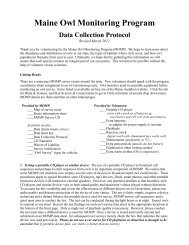Focus Species Forestry - Maine Audubon
Focus Species Forestry - Maine Audubon
Focus Species Forestry - Maine Audubon
You also want an ePaper? Increase the reach of your titles
YUMPU automatically turns print PDFs into web optimized ePapers that Google loves.
2. Characteristics of <strong>Focus</strong> <strong>Species</strong><br />
A Suite of Umbrella <strong>Species</strong><br />
<strong>Focus</strong> species management works because many species inhabit similar forest types. While no<br />
two species have exactly the same habitat requirements, there is often considerable overlap<br />
among species. For example, the American marten, red squirrel, red-breasted nuthatch, spruce<br />
grouse, and hermit thrush have different requirements for food and cover, but they are all found<br />
in mid- to late-successional spruce-fir conifer and mixed conifer-hardwood forests. Because the<br />
marten has the largest home range of this group, it has been identified as a focus species. By<br />
focusing on marten management, other<br />
species with smaller territories will also<br />
benefit. This approach is also called the<br />
“umbrella species” approach, because many<br />
species benefit from the protective<br />
“umbrella” of marten management.<br />
The goal of focus species forestry is to<br />
provide habitat for the vast majority of forest<br />
species. To account for the range of habitat<br />
needs of <strong>Maine</strong>’s wildlife and other aspects<br />
of biodiversity, focus species management is<br />
based on a suite of focus species that cover<br />
the habitat requirements of most other species<br />
found in the area. For example, the marten is<br />
typically found in older forests, while<br />
Umbrella <strong>Species</strong> Effect of Managing for<br />
American Marten in Northern <strong>Maine</strong><br />
<strong>Species</strong> Group Number of <strong>Species</strong> 1<br />
Reptiles 3 (100%)<br />
Amphibians 8 (50%)<br />
Mammals 40 (80%)<br />
Birds 80 (70%)<br />
Plants<br />
Hundreds?<br />
Fungi<br />
Hundreds?<br />
Insects<br />
Thousands?<br />
1<br />
Estimate based on DeGraaf and Yamasaki 2001,<br />
Gawler et al. 1996; percent based on non-aquatic,<br />
forest-dependent species.<br />
animals such as the ruffed grouse, magnolia warbler, and snowshoe hare thrive in younger<br />
conifer forests. This guide includes a suite of focus species that spans the range from early<br />
successional to late-successional forests in <strong>Maine</strong>’s six major forest ecosystems. By also<br />
including two widespread special-value habitats—riparian and wetland forests as well as vernal<br />
pools—the full range of habitats encountered in the course of everyday forestry is covered.<br />
<strong>Focus</strong> species forestry will benefit all reptiles, amphibians, birds, and mammals associated with<br />
<strong>Maine</strong>’s forest. Less is known about the relationship of some plants and forest management, and<br />
knowledge of forest invertebrates and fungi is very limited.<br />
<strong>Focus</strong> <strong>Species</strong> <strong>Forestry</strong> 3



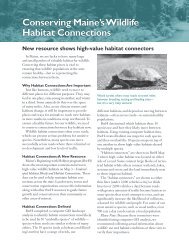
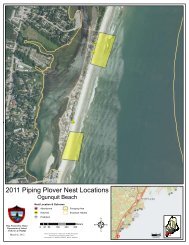
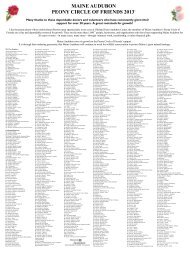
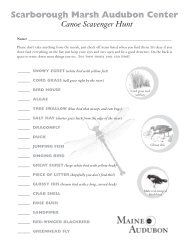


![2012 Loon Count Results [pdf] - Maine Audubon](https://img.yumpu.com/26228732/1/190x245/2012-loon-count-results-pdf-maine-audubon.jpg?quality=85)
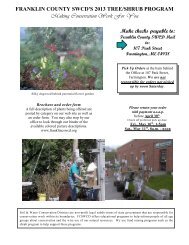
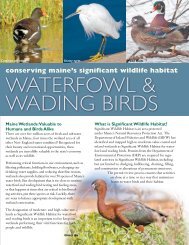
![Lake Fish of Maine (DIFW list) [pdf] - Maine Audubon](https://img.yumpu.com/23282964/1/190x245/lake-fish-of-maine-difw-list-pdf-maine-audubon.jpg?quality=85)
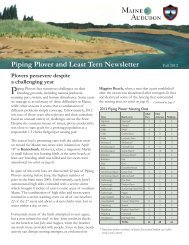

![The Maine Audubon Peony Circle of Friends 2012 [pdf]](https://img.yumpu.com/22707677/1/190x253/the-maine-audubon-peony-circle-of-friends-2012-pdf.jpg?quality=85)
